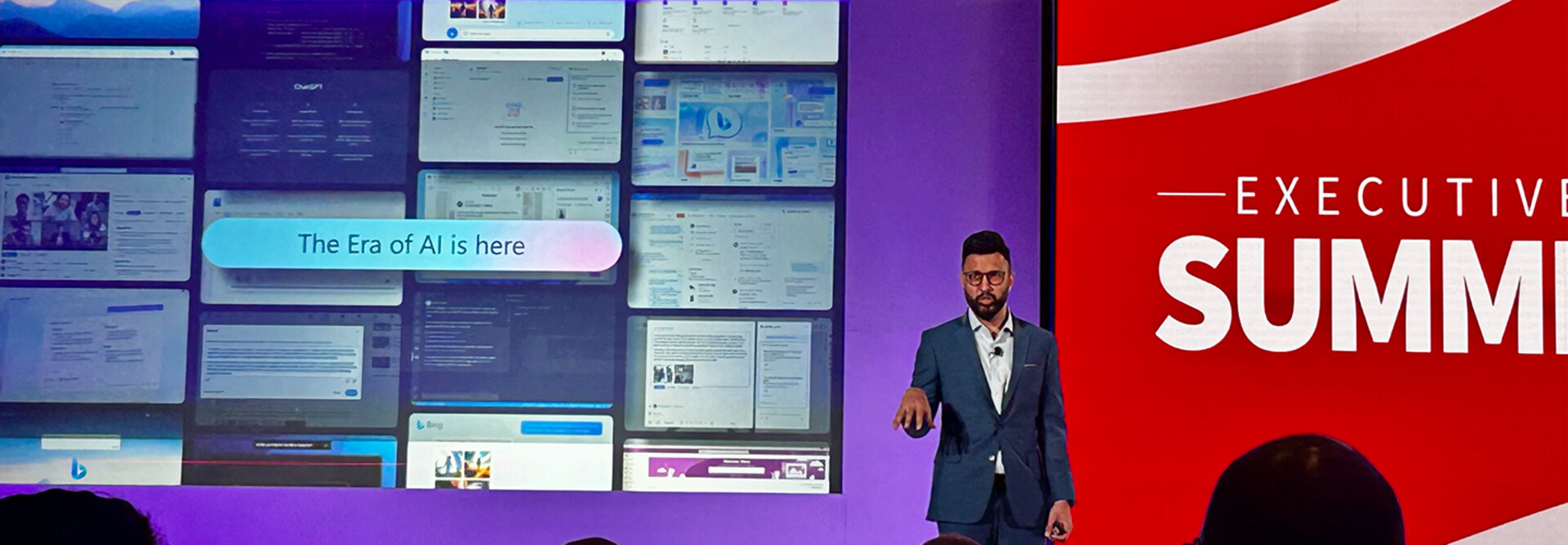It will soon be an “agentic world,” one where “a rich tapestry of artificial intelligence agents, including personal agents, business process agents and cross-organizational agents, work together to enhance productivity and collaboration,” notes Rajamma Krishnamurthy, a senior director of enterprise AI at Microsoft, in a company blog post.
“AI agents are already transforming how work gets done, and IT leaders must ensure their organizations are ready,” said Rishin Barat, general manager of the North American channel at Microsoft, during a session at the April CDW Executive SummIT, hosted in Chicago.
Experts shared how intelligent agents will be able to act with increasing autonomy and perform tasks using their own deep reasoning. But preparing for this shift requires IT decision-makers to assess where AI agents will be most useful.
Microsoft says there are four core pillars where agents can deliver the most ROI: the employee experience, customer engagement, reshaping business process and furthering innovation. Here are a few steps decision-makers can take to turn AI potential into real, measurable outcomes across their organizations.
EXPLORE: Get the solutions and services from Microsoft and CDW to fuel modern work.
Understanding the Agentic Era
Autonomous agents can read and respond to emails, initiate follow-up communications and handle early stage lead qualification without human input. “Agents can also interpret another language in real time,” Barat said, which is particularly helpful in calls with participants from all over the world. “I’m originally from South Africa, and it works beautifully with how it translates voice into text in different languages.”
However, folding these agents into the workflow means not only migrating on-premises data to the cloud for more scalable and flexible access but rethinking how teams, processes and customers interact with technology. It’s about creating an AI-centric enterprise.
“If customers are happy, you continue to grow,” Barat said, explaining how CDW and Microsoft have partnered together to help organizations plan, adopt and optimize AI and see tangible ROI.
Click the banner below to read the new CDW Artificial Intelligence Research Report.
Four Core Pillars of AI-Driven Business Transformation
There are lots of areas where AI can be deployed, but Jim Wray, director of productivity and AI solutions at Microsoft, identified four strategic areas that drive the most business transformation:
- Enriching the Employee Experience: Employees are already bringing generative AI into the workplace with tools such as Microsoft Copilot. A McKinsey report notes that generative AI could boost productivity by 0.6% annually, with the potential to “automate work activities that absorb 60%–70% of employees’ time today.” But IT leaders still need to turn that time savings into revenue. “You’re giving people time back with AI,” Wray said. “But what are they going to do with that time? Will they strategize new solutions, mentor colleagues, upskill their technical skills or strengthen client relationships?” Answering those questions is key.
- Reinventing Customer Engagement: AI can create more compelling customer journeys through personalized recommendations, predictive service and conversational support. But to measure results, teams need to mine analytics from those experience platforms. “True value comes when leaders can connect AI use to measurable business outcomes,” Wray said.
- Reshaping Business Processes: AI agents are “boosting productivity threefold” by speeding up routine tasks, compliance and daily workflows, an Accenture report notes. But IT leaders must think beyond incremental automation and start to reimagine workflows from the ground up so that real-time data is part of every process. The next step is change management, “rethinking how talent is managed, reskilled and aligned with the demands of a generative AI-driven world.”
- Staying Ahead on Innovation: In today’s landscape, being reactive isn’t good enough. Businesses need proactive AI strategies. Wray said to “set a value hypothesis” about how agents will deliver impact, pilot those programs and track the results against KPIs.
Click the banner below to sign up for our BizTech newsletter and receive more tech insights.
From Hype to Hypothesis: Measuring AI’s Value
“Leaders want real value for AI investment,” Wray said. But how do we measure the value of AI? This is “a big, hot topic that I hear all the time now, both in terms of dollars and time,” he added.
Microsoft experts recommend starting with the problem you’re trying to solve, whether that’s time savings, increased output or better decision-making. Once teams have a use case, set a value hypothesis and define KPIs such as task automation rate, time saved per task or increased satisfaction. At this stage, Wray said, IT leaders need to ask themselves some questions: Did AI reduce support ticket resolution times? Did it boost sales conversions from qualified leads? These metrics can help determine ROI.
Addressing Security, Governance and Cost Concerns
Efficiency gains aside, autonomous agents still need to be secure and safe. What happens if someone enters harmful or sensitive data into an AI chat? How can that data be prevented from leaking into public models or third-party systems?
Wray said that making sure these solutions are secure comes down to data governance, monitoring and endpoint protection for every AI interaction.
Preparing for an Agentic Workforce
Right now, businesses see AI agents as tools, but soon they will be digital teammates. That’s a significant shift to hit the workforce, but it’s one that will change businesses from AI-enhanced to AI-empowered. “Agents are already so powerful, but they’re only going to get more powerful,” writes Amy Rosencranz, senior program manager at Microsoft Digital, in a company blog post.
Read more of our CDW Executive SummIT coverage here and consider becoming an Insider to gain exclusive insights on related topics.
This article is brought to you by:















